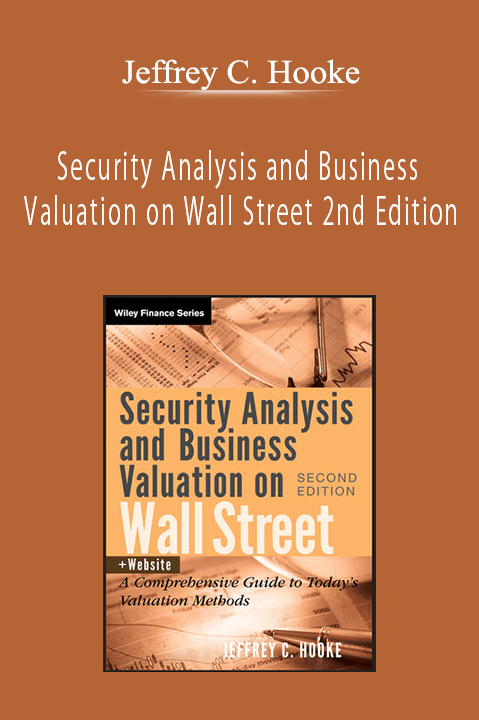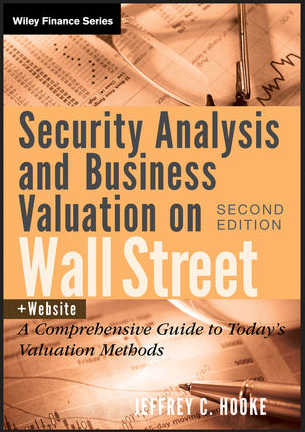Jeffrey C. Hooke – Security Analysis and Business Valuation on Wall Street 2nd Edition
A Comprehensive Guide to Today’s Valuation Methods, + Companion Web Site, 2nd Edition
By: Jeffrey C. Hooke
Publisher: Wiley; 2 edition (2010)
Pages: 408
Format: Ebook (PDF)
Description
An insider’s look at security analysis and business valuation, as practiced by Wall Street, Corporate America, and international businesses
Two major market crashes, numerous financial and accounting scandals, growth in private equity and hedge funds, Sarbanes Oxley and related regulations, and international developments changed security analysis and business valuation substantially over the last fourteen years. These events necessitated a second edition of this modern classic, praised earlier by Barron’s as a “welcome successor to Graham and Dodd” and used in the global CFA exam.
This authoritative book shows the rational, rigorous analysis is still the most successful way to evaluate securities. It picks up where Graham and Dodd’s bestselling Security Analysis – for decades considered the definitive word on the subject – leaves off. Providing a practical viewpoint, Security Analysis on Wall Street shows how the values of common stock are really determined in today’s marketplace. Incorporating dozens of real-world examples, and spotlighting many special analysis cases – including cash flow stocks, unusual industries and distressed securities – this comprehensive resources delivers all the answers to your questions about security analysis and corporate valuation on Wall Street.
The Second Edition of Security Analysis on Wall Street examines how mutual funds, private equity funds, hedge funds, institutional money managers, investment banks, business appraisers, and corporate acquirers perform their craft of security analysis and business valuation in today’s highly charged environment. Completely updated to reflect the latest methodologies, this reliable resource represents the most comprehensive book written by someone who has actually worked as an investment banker, private equity executive, and international institutional investor.
- Shows the methodical process that practitioners use to value common stocks and operating companies and to make buy/sell decisions
- Discusses the impact of the two stock market crashes, the accounting and financial scandals, and the new regulations on the evaluation process
- Covers how Internet and computing power automate portions of the research and analytical effort
- Includes new case study examples representative of valuation issues faced daily by mutual funds, private equity funds, hedge funds, institutional investors, investment banks, business appraisers, and corporate acquirers
- Is a perfect tool for professors wishing to show their MBA students the essential tools of equity and business valuation
Security analysis and business valuation are core financial disciplines for Wall Streeters, corporate acquirers, and international investors. The Second Edition of Security Analysis on Wall Street is an important book for anyone who needs a solid grounding in these critical finance topics.
Table of contents
Preface xiii
What Is Security Analysis? xiv
Recent Trends xv
Why Study Security Analysis and Business Valuation? xvii
Overview of the Contents xviii
What’s New in the Second Edition xviii
PART ONE The Investing Environment 1
CHAPTER 1 Why Analyze a Security? 3
The Origins of Security Analysis 3
No Profit Guarantee 5
Day-to-Day Trading and Security Analysis 6
Herd Psychology and Security Analysis 6
Momentum Investors 7
Game Theory and Security Analysis 8
The Premise of Security Analysis 9
Scientific Method 10
Security Analysis Techniques 12
Basic Valuation Approaches 12
Other Valuation Approaches 14
Summary 16
CHAPTER 2 Who’s Practicing Security Analysis and Business Valuation? 17
Securities Firms and Their Analysts 18
Major Institutional Investors 20
A Dying Art? 21
Index Funds and Exchange-Traded Funds 24
Small Money Management Firms 25
Rating Agencies 26
Individual Investors: A Special Category 26
Business Valuation 28
Summary 28
CHAPTER 3 Seeking a Level Playing Field 29
Brief History of Securities Regulation 30
The Chief Regulator: The Securities and Exchange Commission 32
Sales and Trading Practices 34
Margin Regulation 37
The Life Cycle of a New Security Issue 37
Summary 49
CHAPTER 4 Other Sources of Information 51
The Business Media 51
The Free Internet 53
The Fee-for-Service Internet 53
Trade Associations, Consulting Firms, Government Publications, and Financial Organizations 54
Credit Rating Agencies 54
Securities Firm Research 55
Newswires 56
Independent Expert Services 56
Summary 57
PART TWO Performing the Analysis and Writing the Research Report 59
CHAPTER 5 Starting the Analysis 61
The Security Analysis Process 62
Model Research Report 63
The Analyst’s Responsibility 64
The Cascade of Projections 66
Selecting Stocks for Study: Top-Down versus Bottom-Up 67
Limited Time and Resources 68
The Margin of Safety 69
Summary 70
CHAPTER 6 Industry Analysis 73
Background 73
Organizing an Industry Analysis 75
Industry Classification 75
External Factors 81
Demand Analysis 86
Supply Analysis in the Industry Study 92
Profitability, Pricing, and the Industry Study 94
International Competition and Markets 95
Summary 98
CHAPTER 7 Company-Specific Analysis 99
Systematic Approach of a Business Analysis 101
Overview and Business Description 106
Products and Markets Section 106
Production and Distribution 110
Competition 111
Other Topics Included in the Business Review114
Summary 117
CHAPTER 8 Financial Statement Analysis of an Established Business 119
Beginning the Investigation 120
The Raw Materials of an Analysis 121
Evolution of the Approach to Financial Statements 122
Illustration of the Basic Approach 123
Review of Neiman Marcus Financial Analysis 135
Summary 137
CHAPTER 9 The Limitations of Accounting Data 139
Basic Accounting Issues 141
Global Issues 141
Company-Specific Accounting Issues 145
The Fundamental Objective of Public Companies 149
Case Study: Stability Corporation 150
Summary 163
CHAPTER 10 Financial Analysis and Company Classification 165
Company Classifications 166
The Mature Company 166
The Growth Company 167
The Cyclical Company 169
The Declining Company 175
The Turnaround 175
The Pioneer 175
Financial Games 176
Extra Shares Outstanding? 180
Summary 180
CHAPTER 11 Financial Projection Pointers 181
The Cascade of Projections 182
The Typical Financial Projection 182
Alternate Means of Forecasting 183
Critiquing the Huntsman Chemical Projection 185
Preparing Projections 186
Cyclical Company Forecast 189
Hockey Stick Phenomenon 190
Summary 192
PART THREE Valuation and the Investment Decision 193
CHAPTER 12 Valuation Methodologies 195
Assessing Each Methodology 196
Applying Multiple Methodologies 197
Summary 198
CHAPTER 13 Intrinsic Value and Discounted Cash Flow 199
Issues in Applying Discounted Cash Flow 200
Discounted Cash Flow versus Relative Value 203
Discounted Cash Flow and the P/E Ratio 203
The Discounted Cash Flow Valuation Process 205
Summary 208
CHAPTER 14 Discounted Cash Flow: Choosing the Right Discount Rate 209
Beta 211
The Buildup Method for the Equity Rate of Return 212
Special Cases 213
Summary 215
CHAPTER 15 The Relative Value Approach 217
Real Estate Analogy 218
What’s the Right P/E Ratio? 218
Case Study: Temporary Staffing Services 219
Valuing an Initial Public Offering 222
Balance Sheet Items and Relative Value 223
How High Is Up? 223
Summary 223
CHAPTER 16 Marginal Performers 225
Defining the Problem Company 226
Small Companies and Relative Value 232
Summary 232
CHAPTER 17 The Mergers and Acquisitions Market, Security Analysis, and Valuation 233
Understanding Leveraged Buyouts 235
LBO Mechanics 236
Case Study: Keane, Inc. 237
How Much Can the PE Firm Pay? 237
LBO Valuation and the Security Analysis of a Publicly Traded Company 239
Strategic Takeover Values 240
Summary 241
CHAPTER 18 Sum-of-the-Parts Analysis 243
Background 243
Taxes Favor Spin-Offs versus Cash Sales 244
Sample Sum-of-the-Parts Analysis 245
Business Division Valuation 245
Nonoperating Corporate Assets and Liabilities 250
Unlocking Sum-of-the-Parts Values 250
Summary 251
CHAPTER 19 The Investment Recommendation 253
Summary Top-Down Analysis 255
Discounted Cash Flow Valuation 257
Relative Value/Sum-of-the-Parts Valuation Approach 259
Acquisition Value 261
Leveraged Buyout Method 262
Investment Recommendation 265
Summary 266
PART FOUR Special Cases 267
CHAPTER 20 Private Equity 269
Industry Segmentation and Size 269
Fee Structure 270
Private Equity Does Not Beat the S&P 500 271
Private Equity Funds and Information Collection 271
Private Equity Changes to the Public Company
Valuation Methodology 272
Liquidity and Control Adjustments 273
Summary 277
CHAPTER 21 Natural Resource Companies 279
General Methodology 279
The Financial Reporting of Natural Resource Companies 281
Case Study: Encore Acquisition Company 284
Mining Companies 290
Summary 292
CHAPTER 22 Financial Industry Stocks 293
Product Lines 295
The Nature of Financial Assets 296
Two Sets of Skills 298
Lending 298
Large Commercial Banks 304
Summary 307
CHAPTER 23 Insurance Companies 309
General Background 309
Principal Functions of an Insurance Company 311
Insurance Company Regulation 312
Financial Statement Analysis: Property and Casualty Company 313
Financial Statement Ratios 317
Life Insurance Companies 317
Summary 319
CHAPTER 24 Highly Speculative Stocks 321
Background 321
Discounted Cash Flow 323
Case Study: Ballard Power Systems 324
Venture Capital Markups and IPOs 328
Historical Perspective 329
Security Analysis, Technology Stocks, and Portfolio 329
Summary 330
CHAPTER 25 Distressed Securities and Turnarounds 331
Investment Opportunities 332
Screening Technique 333
Recognize the Options of an Unsuccessful Turnaround 334
Financial Analysis of a Company with Leverage Problems 335
The Investment Decision 338
Evaluating Turnarounds 339
Liquidations 340
Summary 342
CHAPTER 26 International Stocks 343
The Role of Security Analysis 343
American Depositary Receipts 345
Developed Country Markets 346
Relative Value Multiples 349
Summary 350
CHAPTER 27 The Emerging Markets 351
Emerging Markets and Security Analysis 353
Stock Pricing Guidelines 357
Financial Projections 360
Emerging Market Equity Discount Rate 361
Relative Value in the Emerging Markets 364
Summary 366
PART FIVE In Conclusion 367
CHAPTER 28 Asset Booms and Busts 369
The 2008 Crash: Contributing Causes 369
Collapse of the U.S. Housing Bubble 370
Failure of the Referees 371
The Certainty of Another Crash 375
How Might Security Analysis and Business Valuation Change? 377
Summary 378
CHAPTER 29 Closing Thoughts 379
Notes 383
About the Author 385
Index 387
Get Download Jeffrey C. Hooke – Security Analysis and Business Valuation on Wall Street 2nd Edition at Offimc.click Now!
Delivery Information
- Upon ordering the product, a delivery email with download instructions will be sent immediately to you so that you may download your files. If you log in (or create an account) prior to purchase you will also be able to access your downloads from your account dashboard.
- It is a digital download, so please download the order items and save them to your hard drive. In case the link is broken for any reason, please contact us and we will resend the new download link to you.
- If you don't receive the download link, please don’t worry about that. We will update and notify you as soon as possible from 8:00 AM – 8:00 PM (UTC+8).
- Please Contact Us if there are any further questions or concerns you may have. We are always happy to assist!








Reviews
There are no reviews yet.